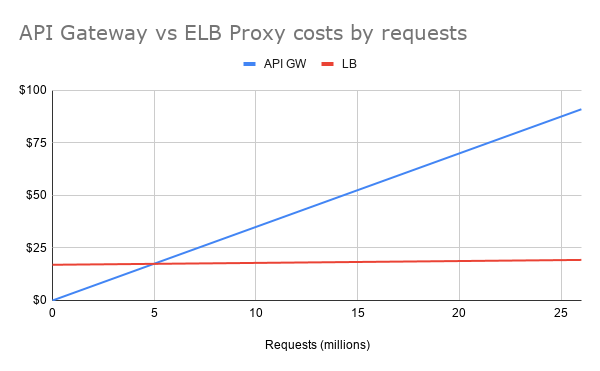Summary: Is API Gateway merely a front end to your Lambda, with no additional configurations? Do you run multiple APIs? Do you see >5 million requests/month in traffic? Perhaps you should switch to an Application Load Balancer Proxy. Here are some considerations.
API Gateway
API Gateway, as you are probably aware, is the de facto standard way to invoke a lambda synchronously. It also adds a lot of extra features, like throttling, stages, pre and post processing, among other features. These additional features, however, come at a cost: $3.50 per million invocations.
Load Balancer Lambda Proxy Integration
If you never heard of this, you can be forgiven. This was relatively new – introduced during the tail end of AWS re:Invent 2018. In short: You can use a load balancer and host/path rules to redirect requests to an AWS Lambda back end. Prior to this feature addition, essentially Lambda was only reachable with API Gateway.
What’s the point
Load Balancer integration allows you to have “up to” 50 APIs behind it for a relatively fixed cost of $25/month.
This was a loaded statement… Let me clarify:
- The more you cram onto a load balancer, the higher the impact on overall performance (e.g. rule evaluations). You may hit other limits (like certs).
- The relatively fixed costs are in comparison to API Gateway.
Here’s another way to look at this:

This makes it fairly obvious: ELB has a fixed ~$17 cost plus the “capacity units” (LCU) variable cost. This variable cost increases in a linear fashion, just like API gateway, but at a slower rate. The exact rate of climb on the load balancer costs is its own calculation, but you’re likely to be hitting the connection-related limits. A load balancer that sees an average of 1 “LCU” of traffic all month will cost ~$23, which equates to 64,000,0000 new connections over the month. An equivalent cost in API gateway is easy to calculate: 64 x 3.50 = $224
Summary
If you expect under 5 million requests/month across your account for the forseeable future: use API Gateway. Once you see 4-5 million being a concern, if you’re still not using any API Gateway features, consider the load balancer proxy. (Also, perhaps investigate if you can handle what API Gateway does for you in your code – Lambdas bill a minimum of 100ms, so will 1ms to convert a header value really cost you anything?)
I wanted to write this article because we encountered this issue at work and I wanted to dig just a bit deeper. For my personal projects, API gateway is not a cost factor at all – My websites & APIs do not see even 1 million hits in a month, and probably never will!
Final considerations:
- If the lambda’s primary purpose is moving a lot of data, you may fall into the data transfer LCU consideration.
- API Gateway has features that may be time consuming to replicate.
- If your lambda can run at a CloudFront Edge (without needing a backing database) you will have slower responses
- You may suffer an outage if all the AZ’s that your load balancer subnets are located in go down.
- Load balancers can automatically health check, keeping some copies of your lambda warm!
- Also remember, you don’t have to be all-in on either side! Maybe mix the two for optimal bill management!